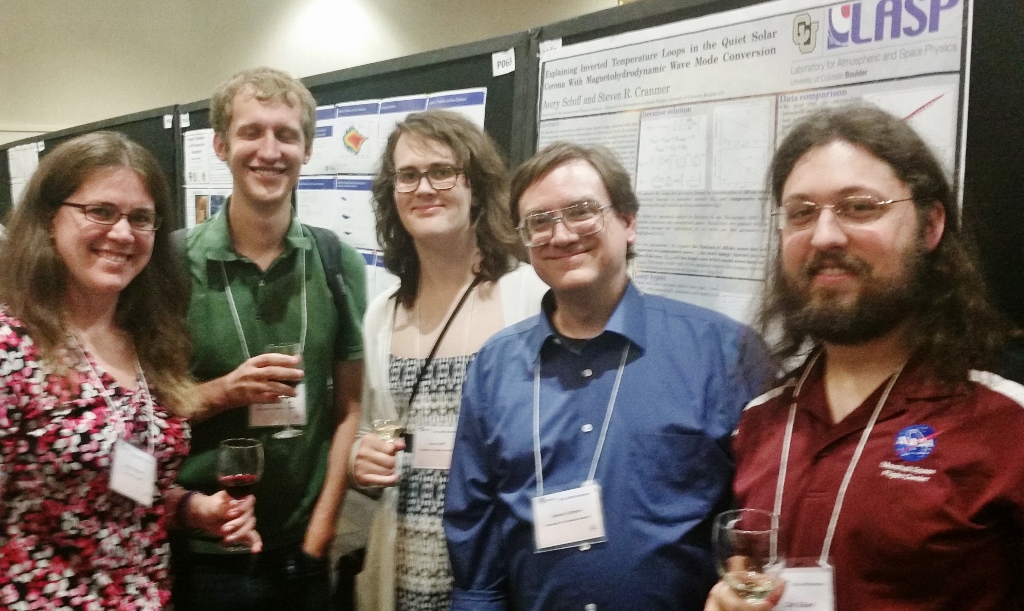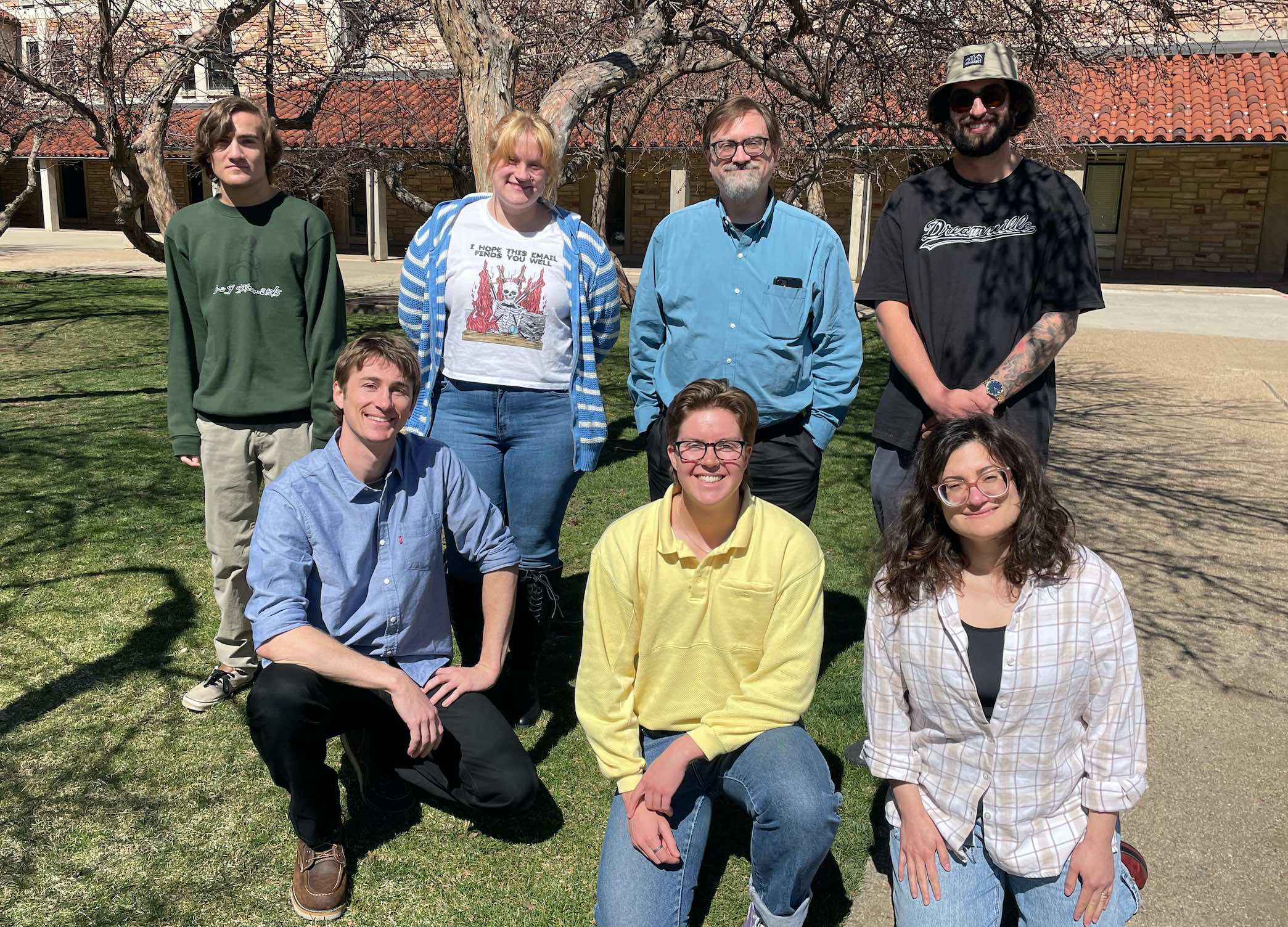
|

|
| (2016 SHINE Workshop) L to R: L. Woolsey, S. Van Kooten, A. Schiff, S. Cranmer, C. Gilly | (2024) standing: T. Simon, A. Lattimer, S. Cranmer, D. Mendoza; in front: P. Tatum, K. Kenny, G. Strus |
Current Students
- I've been serving as the departmental advisor for CU APS graduate
student
Ethan
Cartwright since the summer of 2025.
Ethan is working with
Dr. Lucas Tarr at the NSO on the modeling of
small-scale magnetohydrodynamic structures in the solar photosphere.
- I started working with CU APS graduate student
Garyfallia
Strus in the spring of 2024, on projects
involving plasma waves and turbulence in the solar wind.
- I started working with CU APS undergraduate student
Trestan
Simon in the spring of 2024, on a project involving
data analysis from heliospheric plasma and field instruments that
will help constrain future models of the solar wind.
- I've been working with CU APS graduate student
Daniel
Mendoza since the summer of 2023, on projects
involving the solar coronal heating problem and the testing of
magnetic-field extrapolation techniques.
- I've been serving as the departmental advisor for CU APS graduate student Kenny Kenny since 2021. Kenny is working with Dr. Craig DeForest at the Southwest Research Institute on the analysis of visible-light images of the heliosphere from the WISPR instrument on Parker Solar Probe, and on similar analysis for the upcoming PUNCH mission.
Past Students
- From 2019 to 2024, I advised CU APS graduate student
Aylecia Lattimer,
who completed her dissertation work on
the atomic physics of radiatively driven
flows from stars and active galactic nuclei.
- From 2016 to 2022, I advised CU APS graduate student
Chris Gilly,
who completed his dissertation work on how flows and magnetic fields
in the solar corona can be probed by measuring emission lines
with space-based spectrometers.
- Gilly's PhD thesis on ADS
- From 2016 to 2022, I advised (jointly with Kevin Reardon at NSO)
CU APS graduate student
Momchil
"Momo" Molnar,
who completed his dissertation work on
the topic of waves in the chromosphere and corona, with
observations from ALMA, IRIS, and the Dunn Solar Telescope.
- Momo's PhD thesis on ADS
- From 2016 to 2021, I advised CU APS graduate student
Sam Van Kooten,
who completed his dissertation work on
how the motions of magnetic bright points in the Sun's atmosphere
contribute to waves and plasma heating higher up in the corona.
- From 2015 to 2020, I advised CU APS graduate student
Avery Schiff,
who completed her dissertation work on an interesting mix of
theoretical topics that involved thermal conduction in the solar corona.
- From 2011 to 2016, I advised Harvard University graduate student
Lauren Woolsey,
who completed her dissertation work on models of the acceleration of
the solar wind.
Lauren is now an
Assistant
Professor at Grand Rapids Community College.
- Lauren's PhD thesis on arXiv and Zenodo
- Lauren's PhD defense public talk from May 2, 2016
- In Fall 2015, I supervised a research project
for CU senior undergraduate student Jacob Jost
on the topic of the line-of-sight effect in off-limb observations
of MHD turbulence in the solar corona.
- In Spring and Summer 2018, I supervised research projects for CU undergraduate student Shaniya Jarrett on: (1) plasma fluctuations in the solar wind at 1 AU, and (2) atomic physics of spectral lines that drive winds of massive stars.
Academic Genealogy
- Steven R. Cranmer recieved his Ph.D. in 1996 from the University of Delaware. Thesis title: "Dynamical Models of Winds from Rotating Hot Stars" (lots more info about it here). His advisor was...
- Stanley P. Owocki (web page), who received his Ph.D. in 1982 from the University of Colorado Boulder. Thesis title: "The Ionization State of the Solar Wind." His advisor was...
- Thomas E. Holzer, who received his Ph.D. in 1970 from the University of California, San Diego. Thesis title: "Stellar Winds and Related Flows." His advisor was...
- Well, here it starts to get complicated. Tom Holzer's official university advisor was UCSD's Peter M. Banks. Holzer and Banks wrote some very highly cited papers together. However, the story as I heard it was that Banks was mainly an "on-paper" advisor, and that Holzer's primary mentor for his thesis was really...
- Sir W. Ian Axford (wikipedia), who received his Ph.D. in 1959 from the University of Manchester, UK. Thesis title: "Some Problems in Fluid Dynamics." His advisor was...
- Sir M. James Lighthill (wikipedia), who graduated from Trinity College, Cambridge in 1943, and was elected a fellow of Trinity College in 1945. I still haven't figured out whether or not he had a formal advisor in the modern sense. However, there is a fun way to trace his "lineage" even further back in time. In 1969, Lighthill became the 16th Lucasian Professor of Mathematics at Cambridge. His predecessors in the Lucasian "Chair" included Paul Dirac, George Stokes, Charles Babbage, George Airy, and...
- Sir Isaac Newton!

Erdős Number
As best as I can tell, my Erdős number is no larger than 5, with the shortest chain of coauthorships being:
S. R. Cranmer (5) → George B. Field (4) → John N. Bahcall (3) → Freeman J. Dyson (2) → Dean Robert Hickerson (1) → Paul Erdős